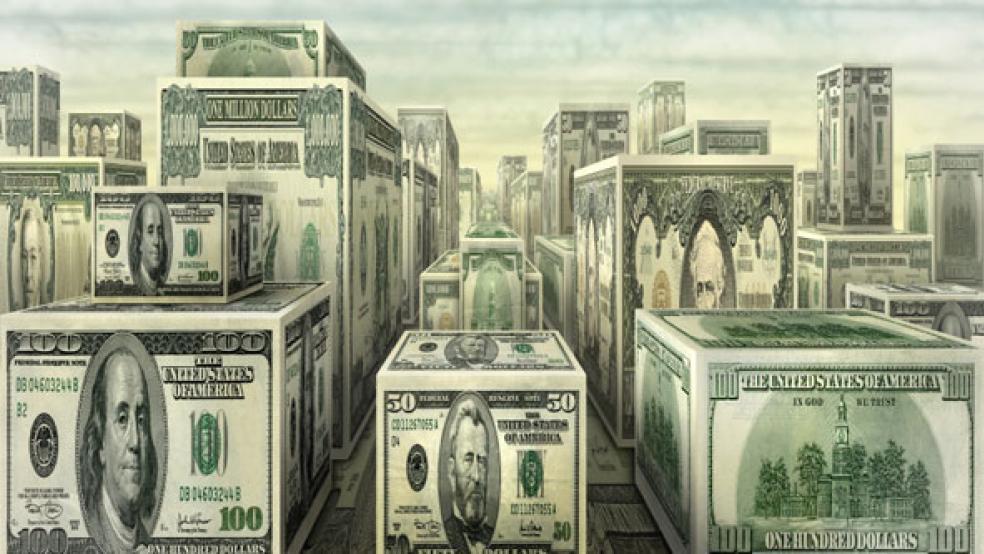The U.S. dollar has been on an incredible run higher, up roughly 8 percent since July in barnstorming fashion: The greenback has broken a long-term resistance line going back to 2005, is up 11 weeks in a row against other major currencies and has only suffered three weekly declines since April.
The move is being driven by a combination of U.S. economic strength, foreign economic weakness, a hawkish turn of U.S. monetary policy relative to the rest of the world, U.S. stock market outperformance and even American military muscle. And the strength looks set to continue.
Related: 3 Steps to a More Fed-Proof Portfolio
Geopolitical tensions in the Middle East, an unsteady ceasefire in Ukraine, pro-independence votes in Europe and pro-democracy protests in Hong Kong are all supportive of the greenback. Moreover, should the Republicans retake the Senate in this year's mid-term elections, the potential for a more pro-business/pro-free-market Congress will be supportive as well.
On balance, this is a good thing for most Americans in the near-term. While a stronger currency will weigh on U.S. GDP growth (by reducing exports as they become relatively more expensive overseas), since the U.S. imports about 20 percent more than it exports, a stronger dollar will be supportive of global GDP.
With America already serving as a pocket of strength while economies throughout Asia, Europe and the emerging world stall, this could be exactly the shot in the arm the world needs.
It'll also be good news for U.S. consumers heading into the holiday shopping season, since a stronger dollar will reduce the cost of imported goods, keep inflation down and weigh on energy prices.
Gluskin Sheff economist David Rosenberg believes the dollar rally could just be getting started. Another 25 percent climb would merely take the dollar back to levels that prevailed in the depths of the 2001 dotcom wipeout. Moreover, the dollar is still at barely half the level it was at the pre-1985, pre-Plaza Accord highs.
Over the longer term, though, the return of "King Dollar" back to its Reagan-era highs may not be a good thing. In fact, it could be a disaster if it happens too fast, undermining the assumption that has supported the global economy since the financial crisis — that is, that dollars would be plentiful and cheap for a long time to come.
Related: Is the Market Bubble About to Burst?
This is the assumption the Federal Reserve has actively encouraged, repeatedly erring on the side of more cheap money and holding rates well below where rules-driven policy would have them. There have been side comments as well, including reports former Fed Chairman Ben Bernanke told investors privately that he didn't expect interest rates to normalize in his lifetime.
It's an assumption, like the fantasy that home prices would never decline nationally or that the dotcom bubble was sustainable, that will look gravely mistaken in retrospect. That's because the evidence suggests a stronger dollar could set off a wave of capital flight from foreign markets, which would be a problem given how dependent many of these countries have become on cheap credit in papering over unreformed, uncompetitive economies.
As an example, the euro's strength between 2012 and May of this year helped quell the eurozone debt crisis by attracting foreign capital into peripheral sovereign bonds, pushing down the borrowing costs of countries like Greece, Portugal and others. Just over the past year, Portugal's 10-year bond yield has dropped from 6.8 percent to 3.1 percent.
A decline in the euro as the dollar strengthens would reverse this dynamic and reveal the fact that the causes of the original crisis remain unresolved.
It's a similar situation with places like Brazil and China. Even Japan, which has been trying to actively weaken the yen in a last-ditch effort to reinvigorate its economy via exports, has arguably reached the point where more currency weakness is a potentially destabilizing factor. Exports have yet to respond (many Japanese manufacturers have offshored production) while the negative effects — higher costs for imported food and energy — are dragging on Japanese consumers.
The world had become comfortable with a cheap and plentiful dollar. With the Federal Reserve set to end its QE3 buying program in a matter of weeks, and looking ahead to the first short-term interest rate hike since 2006, that's all about to change.
Related: Yellen vs. the Inflation Hawks: When Will Rate Hikes Happen?
The flashpoint could be emerging Asia, where according to Morgan Stanley foreign debt has increased from $300 billion to $2.5 trillion over the last decade — much of which was financed with cheap dollars.
Globally, according to the Bank for International Settlements, cross-border lending by banks alone has jumped from $4 trillion to $10 trillion over the last decade. Of this, $7 trillion is denominated in dollars. This total does not include what's happening in the bond market. A study by the International Monetary Fund found the Fed's bond buying stimulus has pushed nearly $500 billion into emerging markets that otherwise would not have gone there.
As the dollar strengthens, both due to higher interest rates and a higher exchange rate, it will become harder and harder for all these debts to be rolled over. A credit crunch could result, crushing the debt-fueled growth model of countries like China.
Last year's "taper tantrum" in response to the Fed teasing the beginning of the end of the QE3 bond purchase program was merely a preview, and January’s emerging-markets scare briefly rocked global markets and filled headlines with talk of the "Fragile Five" — India, Indonesia, South Africa, Brazil and Turkey, all countries with large current account deficits and a heavy reliance on foreign sources of funding.
The market got over its jitters, but a "rates rage" — referring to both interest rates and exchange rates — could hit again while the dollar soars.
Top Reads from The Fiscal Times:






